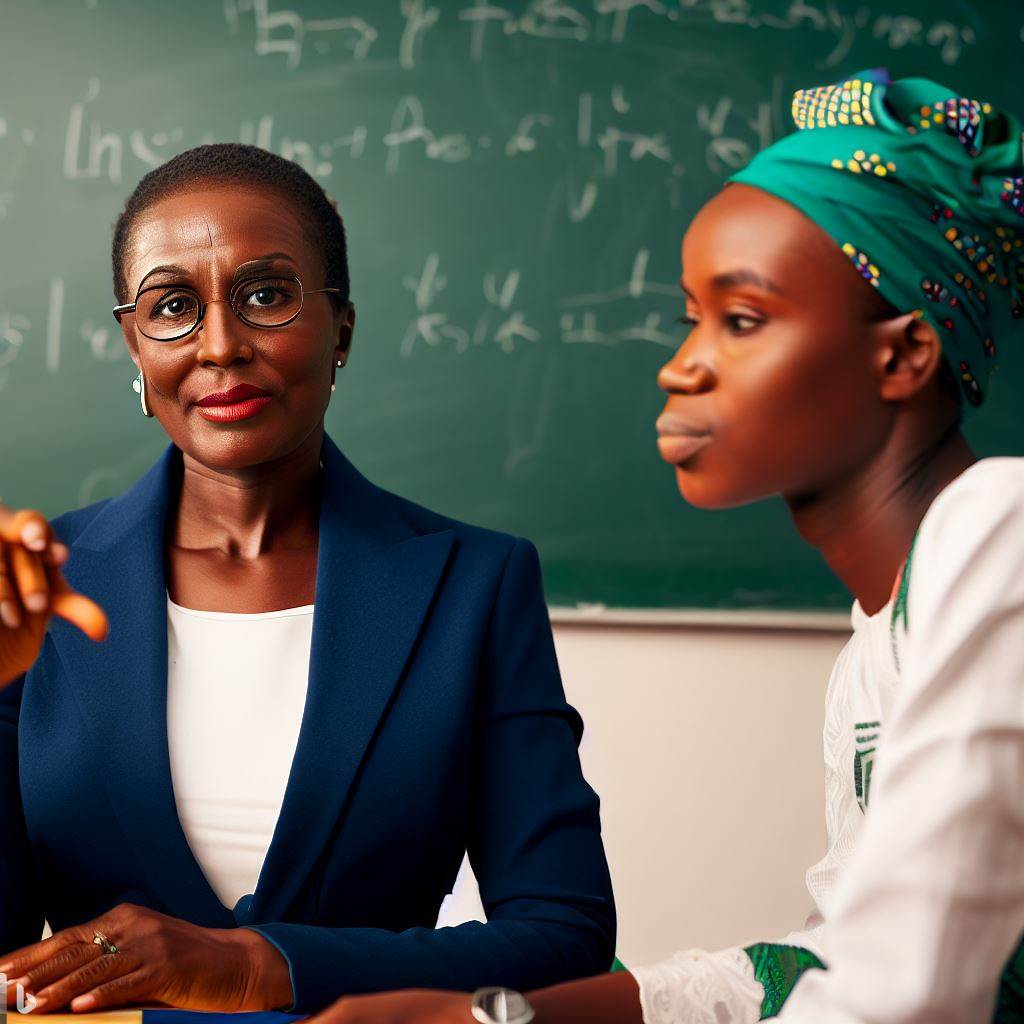Introduction
The education crisis in Nigeria is evident as almost 60% of children are not in school, highlighting the pressing need to address this issue. The role of public vs private school teaching in Nigeria remains crucial.
The Nigerian education system is plagued by inadequate funding, overcrowded classrooms, and lack of qualified teachers.
The blog post aims to compare and contrast public and private school teaching in Nigeria, highlighting their differences and impact on education quality.
Public vs. Private School Teaching in Nigeria
In Nigeria, the education system faces numerous challenges, resulting in a significant number of children being denied access to quality education.
According to UNICEF, nearly 60% of Nigerian children are out of school, shedding light on the urgent need for improvement.
Public schools, operated by the government, often suffer from a lack of infrastructure and resources.
Overcrowded classrooms make it difficult for teachers to provide individual attention and cater to students’ specific needs.
Additionally, the shortage of qualified teachers further hampers the quality of education in public schools.
On the other hand, private schools in Nigeria have emerged as an alternative, promising better educational standards.
These schools usually have well-equipped facilities, smaller class sizes, and qualified teachers.
However, the accessibility and affordability of private schools remain a concern, as they cater mostly to the elite and affluent sections of society.
The disparities between public and private schools in Nigeria raise questions about equity and access to quality education.
While private schools may offer better infrastructural facilities, their limited reach excludes a significant portion of the population.
Public schools, despite their challenges, remain the primary option for most Nigerians due to financial constraints.
This blog post intends to delve into the intricacies of public and private school teaching in Nigeria, examining the ways in which they differ and their impact on overall education quality.
By analyzing the strengths and weaknesses of both systems, we can gain insights into potential strategies for improving the Nigerian education system as a whole.
Definition of Public and Private Schools in Nigeria
In Nigeria, public schools are government-owned institutions that provide education accessible to all students.
They are funded by the government, usually state or federal, and follow a standardized curriculum.
A. Characteristics and features of public schools in Nigeria
- Accessibility: Public schools aim to provide education to a broad range of students, regardless of their socioeconomic background.
- Affordability: Tuition fees in public schools are typically lower compared to private schools, making them more affordable for many families.
- Government funding: Public schools receive financial support from the government, which covers expenses such as teacher salaries, infrastructure development, and educational materials.
- Larger class sizes: Due to the high demand for public schools, class sizes tend to be larger, resulting in less individual attention for students.
- Standardized curriculum: Public schools follow a uniform curriculum set by the government, ensuring that students receive the same education regardless of the institution they attend.
On the other hand, private schools in Nigeria are owned and managed by individuals or organizations. They operate independently of government control and have the freedom to design their own curriculum.
B. Characteristics and features of private schools in Nigeria
- Selective admissions: Private schools often have a rigorous admissions process and may require entrance exams or interviews to ensure that they enroll academically capable students.
- Higher fees: Private schools tend to have higher tuition fees compared to public schools, as they rely on these fees to cover their expenses.
- Smaller class sizes: Private schools often maintain smaller class sizes, allowing for more personalized attention and interaction between teachers and students.
- Specialized curricula: Private schools have the flexibility to design their own curriculum, emphasizing specific subjects or teaching methods according to their educational philosophy.
- Access to additional resources: Private schools may have better facilities, resources, and extracurricular activities compared to public schools, as they can invest more in these areas.
C. Differences between public and private schools in Nigeria
The main differences between public and private schools in Nigeria can be summarized as follows:
- Ownership and control: Public schools are government-owned and run, while private schools are owned and managed by individuals or organizations.
- Funding: Public schools receive financial support from the government, while private schools rely on tuition fees and other funding sources.
- Admission criteria: Public schools generally accept all students within their catchment area, while private schools may have selective admissions based on academic performance or other criteria.
- Curriculum: Public schools follow a standardized curriculum set by the government, whereas private schools have the freedom to design their own curriculum.
- Class sizes: Public schools tend to have larger class sizes, while private schools usually maintain smaller class sizes for more individualized attention.
Most importantly, the differences between public and private schools in Nigeria lie in ownership, funding, admissions, curriculum, and class sizes.
Public schools provide accessible education at a more affordable cost, while private schools offer specialized curricula and smaller class sizes at a higher fee.
Both types of schools play significant roles in the Nigerian education system, catering to different needs and preferences of students and parents.
Read: Teacher Salaries in Nigeria: A Comprehensive Review
Teaching Conditions in Public Schools
A. Class sizes and overcrowding issues
Public schools in Nigeria often face the challenge of large class sizes and overcrowding.
With limited resources and inadequate infrastructure, classrooms become crammed with students, hindering effective teaching and learning. Teachers find it arduous to manage a room full of eager learners.
B. Lack of instructional materials and resources
Public schools in Nigeria often lack the necessary instructional materials and resources needed for effective teaching.
The limited availability of textbooks, workbooks, and visual aids severely hampers the teaching process.
Teachers are forced to rely on outdated materials or resort to improvisation, compromising the quality of education.
C. Insufficient funding and poor infrastructure
Public schools in Nigeria suffer from insufficient funding and poor infrastructure. Many schools lack proper facilities such as adequate classrooms, laboratories, libraries, and playgrounds.
Moreover, the lack of regular maintenance and upgrades results in deteriorating conditions, making it challenging for teachers to create an optimal learning environment.
D. Emphasize the impact of these conditions on teaching and learning
The adverse teaching conditions in public schools have a significant impact on both the teachers and students. Packed classrooms make individual attention and personalized instruction nearly impossible.
The absence of essential instructional materials inhibits the teachers’ ability to effectively convey information and engage students.
This, in turn, affects students’ comprehension and hinders their overall academic performance.
Furthermore, inadequate funding and poor infrastructure create a discouraging atmosphere for teachers and students alike.
Teachers may become demotivated due to the lack of resources, while students may struggle to focus in substandard environments.
Additionally, the absence of proper facilities inhibits the practical application of theoretical knowledge, limiting students’ overall growth and development.
The impact of these conditions is particularly evident in the quality of education provided in public schools.
Without proper resources and supportive infrastructure, students are often unable to achieve their full potential.
The lack of individual attention and adequate teaching materials hinders critical thinking, problem-solving skills, and practical knowledge acquisition.
In fact, the teaching conditions in public schools in Nigeria are far from ideal. Class sizes are often too large, instructional materials are lacking, and funding and infrastructure are insufficient.
These conditions significantly hinder the teaching and learning process, affecting both teachers and students.
To improve the quality of education in public schools, there is an urgent need for increased investment in resources, infrastructure, and teacher training.
Only then can Nigeria’s public education system provide its students with the opportunities they deserve for a brighter future.
Read: Challenges Faced by Teachers in Nigeria’s Rural Areas
Teaching Conditions in Private Schools
Private schools in Nigeria are known for providing a conducive environment for teaching and learning.
These schools have various conditions that enhance the quality of education being delivered.
A. Smaller class sizes and personalized attention
B. Availability of modern facilities and instructional resources
A significant advantage of teaching in private schools is the smaller class sizes. Typically, private schools have fewer students in each class, allowing teachers to give personalized attention to each student.
This personalized approach fosters a better student-teacher relationship, which positively impacts the learning process.
The ability to address individual student needs is a crucial factor in improving the quality of education.
Furthermore, private schools have better access to modern facilities and instructional resources. They invest in state-of-the-art technology, well-equipped libraries, science labs, and sports facilities.
These resources enable teachers to provide hands-on learning experiences and facilitate interactive teaching methods.
With access to modern facilities, students can engage in practical learning, enhancing their understanding of concepts and promoting active participation in class.
C. Better salaries and benefits for teachers
Teachers in private schools also enjoy better salaries and benefits compared to their counterparts in public schools.
Private schools recognize the value of quality education and understand that attracting and retaining skilled teachers is essential.
Higher salaries and improved benefits motivate teachers, ensuring they are committed to their profession.
This, in turn, positively affects the teaching-learning process as motivated teachers tend to go the extra mile to deliver high-quality education.
D. Advantages of these conditions for teaching and learning
Teaching in private schools offers several advantages for both teachers and students.
The smaller class sizes allow teachers to focus on individual student needs, resulting in personalized attention and enhanced learning outcomes.
Students can receive more targeted support, enabling them to grasp concepts more effectively and perform better academically.
Additionally, the availability of modern facilities and instructional resources provides opportunities for innovative teaching strategies.
Teachers can use technology, conduct experiments in well-equipped laboratories, and encourage students to explore different subjects through a wide range of resources.
This not only makes the learning process engaging but also helps students develop important skills such as critical thinking, problem-solving, and collaborative work.
Moreover, the provision of better salaries and benefits for teachers attracts highly qualified professionals to private schools.
This ensures that students have access to well-trained and experienced teachers who can effectively deliver the curriculum.
The expertise and dedication of these teachers contribute to creating a positive and stimulating learning environment, which ultimately benefits the students’ academic and personal growth.
In a nutshell, teaching conditions in private schools in Nigeria offer numerous advantages for both teachers and students.
Smaller class sizes and personalized attention enable teachers to address individual needs effectively. The availability of modern facilities and instructional resources enhances the learning experience.
Additionally, better salaries and benefits motivate teachers to deliver high-quality education.
These favorable conditions contribute to creating a conducive environment for teaching and learning, leading to improved educational outcomes in private schools.
Read: The Influence of Nigerian Culture on Teaching Methods
Curriculum and Academic Standards
A. National Curriculum in Public Schools
Public schools in Nigeria adhere to the national curriculum, set by educational authorities. It provides a structured framework for subjects, aiming to offer a well-rounded education.
B. Challenges of Curriculum Implementation
Implementing the national curriculum in public schools faces hurdles like outdated materials, large class sizes, and limited resources. These challenges hinder effective teaching and learning.
C. Flexibility and Standards in Private Schools
Private schools enjoy more flexibility in curriculum design. They often adopt international or specialized curricula, focusing on holistic development and practical skills, along with meeting academic standards.
D. Impact on Teaching and Student Achievements
- Diverse Approaches: Curriculum differences lead to varied teaching methods between public and private schools.
- Academic Performance: Private schools tend to have higher academic achievements due to tailored curricula and better resources.
- Critical Thinking: Private schools prioritize critical thinking, while public schools may struggle with rote learning.
- Holistic Development: Private schools’ flexible curricula address life skills and individual talents, fostering holistic growth.
- Resource Gap: Limited resources in public schools affect the quality of education and student outcomes.
- Standardized Tests: Public schools align with national exams, while private schools might prepare students for international assessments.
In essence, the curriculum disparity between public and private schools in Nigeria influences teaching approaches and student achievements.
Public schools face challenges in curriculum implementation due to resource constraints. Private schools, with their tailored curricula, tend to excel in academic and holistic development.
To bridge the gap, improving public school resources and modernizing the curriculum is crucial.
Read: Becoming a Teacher in Nigeria: An In-depth Guide

Professional Development and Support
A. Limited Availability of Professional Development Opportunities in Public Schools
- Inadequate resources and funding contribute to the limited availability of professional development opportunities.
- Public schools often struggle to provide teachers with the necessary training and support.
- Due to the large class sizes and overwhelming workload, teachers in public schools have little time for professional development.
- Lack of government investment in educational programs further hinders the access to professional development opportunities.
- In public schools, teachers may have limited access to workshops, conferences, and other forms of professional development.
B. Support System and Training in Private Schools
- Private schools generally have stronger financial resources, allowing them to invest more in professional development.
- Private schools often prioritize the support and training of their teaching staff.
- They have the ability to hire experienced mentors who provide guidance and support to teachers.
- Private schools allocate dedicated time and resources for professional development activities.
- Various training programs, workshops, and seminars are organized to enhance teaching skills in private schools.
C. Importance of Continuous Professional Growth for Teachers
- Continuous professional growth is essential for teachers to keep up with changing educational trends and techniques.
- Ongoing professional development allows teachers to improve their knowledge and skills, resulting in better student outcomes.
- Teachers who engage in continuous professional growth can adapt their teaching methods to meet diverse student needs.
- Professional development fosters a sense of motivation, enthusiasm, and innovation among teachers.
- It also helps teachers stay updated with the latest research and advancements in their respective fields.
In short, the disparity in professional development opportunities between public and private schools in Nigeria is evident.
Public schools face challenges due to limited resources and funding, leading to a lack of training and support for teachers.
On the other hand, private schools prioritize the professional growth of their teaching staff and allocate resources to provide adequate training and support.
Continuous professional development for teachers is of utmost importance, as it equips them with the necessary skills, knowledge, and motivation to deliver quality education to students.
It is imperative for the government and stakeholders to address the limited availability of professional development opportunities in public schools to ensure the overall improvement of the education sector in Nigeria.
Read: Insights into the Teaching Profession in Nigeria Today
Discover More: Improving Special Education with Nigerian Government Policies
Compensation and Job Security
A. The issue of low salaries and delayed payments in public schools
- The issue of low salaries in public schools has been a long-standing concern.
- Teachers in public schools often struggle to make ends meet due to meager pay.
- Delayed payments further exacerbate the financial difficulties faced by educators.
- It is disheartening to see dedicated teachers facing financial hardships despite their commitment.
- The government must address this issue by increasing salaries and ensuring timely payments.
B. The comparatively higher salaries and benefits in private schools
- One of the attractive aspects of teaching in private schools is the comparatively higher salaries.
- Private institutions recognize the importance of well-compensated educators.
- Better salaries in private schools motivate teachers and enhance their job satisfaction.
- In addition to higher pay, private school teachers often enjoy benefits such as health insurance and retirement plans.
- These additional perks make teaching in private schools an appealing career choice.
C. Examine the job security and stability in the two sectors
- Job security is a major concern for teachers, especially in a country like Nigeria.
- In public schools, the employment situation can be uncertain, with temporary contracts and frequent changes.
- Teachers in public schools often face the fear of losing their jobs due to government budget cuts or policy changes.
- Contrarily, private schools tend to provide more stability in terms of employment opportunities.
- Private school teachers often have permanent positions, with contracts that offer greater job security.
All in all, compensation and job security play crucial roles in the public vs. private school teaching comparison in Nigeria.
Public school teachers struggle with low salaries and delayed payments, which can create financial hardships and dissatisfaction.
On the other hand, private school teachers enjoy comparatively higher salaries and additional benefits like health insurance, enhancing their job satisfaction.
Moreover, private schools tend to provide more employment stability with permanent positions, while public schools often suffer from uncertain contracts and potential job loss.
The government should prioritize improving compensation and job security for public school teachers to attract and retain the best educators in the country.
Read: A Comprehensive Overview of Special Education in Nigeria
Student Diversity and Inclusion
A. Diversity Among Students in Public Schools
In public schools in Nigeria, student diversity is prevalent due to various factors such as ethnicity, religion, and socioeconomic backgrounds.
Students from different ethnic groups, including Igbo, Yoruba, and Hausa, attend public schools.
This diversity extends to religious backgrounds, with students practicing Christianity, Islam, and traditional African religions.
Furthermore, public schools often cater to students from different socioeconomic backgrounds, including low-income families and affluent households.
This diversity provides a valuable learning experience for students, enabling them to interact and learn from individuals with different perspectives and experiences.
B. The Inclusive Environment Created in Private Schools
Private schools in Nigeria are known for creating inclusive environments where students from diverse backgrounds feel welcome and valued.
These schools prioritize cultural inclusivity and often celebrate diversity through various activities and events.
Private schools actively promote tolerance, understanding, and respect among students, fostering a sense of unity.
They also provide support systems, such as counseling services, to ensure that students from different backgrounds feel included and supported in their educational journey.
Private schools often have smaller class sizes, which allows teachers to give individual attention to students and address their unique needs.
C. The Impact of Student Diversity on the Teaching and Learning Process
Student diversity has a profound impact on the teaching and learning process in both public and private schools.
In public schools, diversity challenges teachers to adopt inclusive teaching strategies that cater to the varied needs of students.
Teachers must design lessons that accommodate different learning styles, cultural perspectives, and languages.
This diversity fosters creativity and critical thinking among students as they learn to collaborate and appreciate diverse viewpoints.
In private schools, the inclusive environment facilitates better engagement among students, leading to enhanced learning outcomes.
Students benefit from exposure to different cultures, beliefs, and values, developing a broader worldview.
Furthermore, the inclusive environment in private schools encourages students to express themselves freely and explore their unique talents and abilities.
Basically, student diversity is a prominent feature in public schools in Nigeria, encompassing variations in ethnicity, religion, and socioeconomic backgrounds.
Private schools, on the other hand, are renowned for their inclusive environments that celebrate diversity and support students’ needs.
Both public and private schools recognize the impact of student diversity on the teaching and learning process, leading to the adoption of inclusive practices.
This acknowledgment fosters a positive and enriching educational experience for students, preparing them to thrive in a diverse world.
Conclusion
In this blog post, we discussed the differences between public and private school teaching in Nigeria.
Public schools offer limited resources and overcrowded classrooms, while private schools provide quality education and better facilities.
It is evident that private school teaching in Nigeria surpasses public school education in terms of quality and opportunities.
However, this disparity highlights the need for the government to invest more in public education to bridge the gap.
As individuals, it is crucial for us to advocate for equal access to quality education for all Nigerian children.
Let us reflect on the education system in Nigeria and work towards implementing positive changes that benefit every student.
Together, we can build a brighter future and ensure that every child receives the education they deserve.




